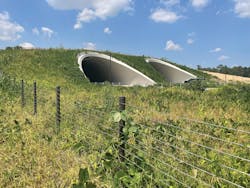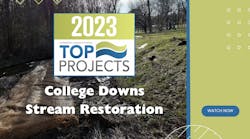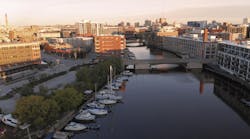Every year, SWS spotlights the best projects from the past year. These 10 projects highlight challenging projects in the storm water and erosion control industry that sought creative solutions. Whether the projects focused on erosion control, watershed management, or green infrastructure, this year's projects required innovative solutions and collaboration between numerous project stakeholders. SWS thanks everyone who submitted projects this year, and we look forward to seeing the innovative projects that are nominated next year.
______________
Memorial Park Restoration Efforts Bridge Green Infrastructure & Erosion Control
Memorial Park is Houston’s largest urban wilderness, but recent population growth has had some negative impacts on the natural landscape, which is there this year’s #1 Top Project comes in.
With population growth in the last several decades, Houston has seen an increase in highways, buildings and paved surfaces that have decreased the prairie acreage, which in turn has negatively impacted the way the prairie handles stormwater – hurricanes, floods and droughts.
Between Hurricane Harvey and a 2011 drought that destroyed up to 90% of the tree canopy in certain areas of the park, an impactful solution was needed. In 2018, more than 30,000 Houston residents, along with the city, created the Master Plan. The plan reimagines Memorial park with an emphasis on the necessity of revitalizing the coastal prairie.
Ultimately, the goal was to implement green infrastructure that would bind the ecosystem together across the park. To get the desired end result, a set of subset goals was established, which included; amending the soil to create optimal growing conditions; restore the native plant life; apply the right solution on the first try; apply an erosion control product to hold seed and soil in place until germination; and create long-term improvement of drainage during floods and retention during droughts.
Additionally, the project sought to connect the two halves of Memorial Park that were previously separated by a divided four-lane boulevard. A land bridge was implemented that provides a connection via safe crossing for pedestrians, cyclists, and even wildlife.
Before all of this, the team had to overcome certain challenges. First, the team found poor soil conditions. The soil tests taken across the site showed low organic matter at just 0.6%, significantly lower than the ideal 5%. In turn, the conservation team researched soil amendments and ultimately chose a biotic soil media for the project site. In 2020, the team redid the soil tests and found a 116% increase in organic matter, a 148% increase in cation exchange capacity and a 423% increase in respiration. Over 90 seed varieties were selected for this project, all of which should help the team meet their goal of restoring the coastal plains.
Another challenge the team faced was in vegetating the slopes. The land bridge has several steep slopes around the highway tunnels, so the team wanted to establish vegetation in those areas to combat erosion. The team chose a turf reinforcement mat that holds the seed and soil in place while encouraging a vegetative establishment.
“Going into the application phase, project partners had high expectations that the solution would perform as stated,” TK said. “ Now months later, the entire tunnel areas have established both short-term and long-term native and cover crop vegetation. It’s a proud moment when all of the planning and engineering comes together to create something that’s effective. Most importantly, all that hard work is providing a safe green space for pedestrians and wildlife —bettering the community and the environment.”
The team said that by choosing to put more greenery over the concrete highway, the storm water now has additional green spaces to mitigate flooding and avoid more canopy damage, which is what happened in 2011.
Project completion is anticipated for December 2022, but so far, the project team calls the project a success.
Location: Houston, Texas
Cost: $200 million
Size: 100 acres
Owner: Uptown Association & the City of Houston
Designer: Nelson Boyd Woltz- Landscape Architects
Contractors: Tellepsen – General Contractor; Construction EcoServices K4 Environmental – Installation Subcontractor; Shooter & Lindsey – Landscape Contractor and; Stormwater Structures – Profile Distributor
Manufacturer: FINN






